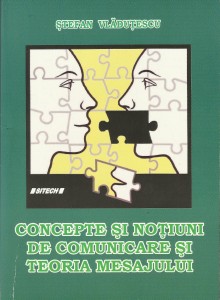Ştefan Vlăduţescu : The magic of communication
by Mirela Teodorescu
Having published many books in this field, and with an excellent CV, Ştefan Vlăduţescu is an expert on communication, an expert fascinated by the diversity of elements interwined here such as notions of: sociology, psychology, philosophy, philology, journalism, public relations, IT, mathematics. He crafts these concepts very skillfully in his volume „Concepts and notions of communication and the theory of the message”. (Craiova, Editura Sitech, 2009).
Communication is an event made by a certain number of communicational facts and actions. „Man communicates, either he wants it or not.” When he communicates with a purpose, that manifestation becomes a communicational act. Communicational facts occur mainly in the case of nonverbal communication.
The author furnishes a generous space for topics of communication represented by conviction and persuasion. „First of all, our world is one of truth simulacrae. The fundamental gnosiological human condition is the following: every moment in life, through conviction (genuine persuasion) or persuasion (abusively induced determination) the spirit selects what is true from that which seems true.”(p.169).
The cultural history of persuasion begins with Greek sophists as being an inquisitive method of communication by using procedures such as: rumours, lies, sophisms, eclairages, myths, fascinations. In the case of persuasion, once the mechanism is mastered along with the methods and result evaluation, this leads to addiction, it becomes a drug and an instrument of manipulation and intoxication.
Conviction is about the communication act that tackles the mental state of an individual by being an efficient method of influencing of people and it is based on the reason, the truth, logical deductions, argument layering, testing and confirmations.
In the case of communications, axioms help its construction; one needs structured „sentences”, principles of organisation of the noetic material and its meanings.” (p.63). It should be mentioned here that there is a substantial Romanian contribution to this avail, through M. Dinu. He has based his work on a natural logic of communication hues, by modifying the psychology-proned dynamics of Palo Alto axioms, rephrasing them and adding two more. The axioms noted by M. Dinu are (M. Dinu, 1999, p. 99-107):
- „Noncommunication is impossible”;
- „Communication unravels two layers: informative and relational”;
- „Communication is a continuous process that cannot be seen as a cause and effect relationship.”
- „Communication is either digital or analogical.”
- „Communication is irreversible.”
- „Communication implies strength relationships as it implies symmetrical transactions or complementary.”
- „Communication implies processes of adjustment and accommodation.”
Communication is not a predetermined structure: ”its rules build along the exchange.”
(M.F. Agnoletti, 1988) on condition that there is a common repertoire for a minimum understanding.” (p. 86).
Systems theory is a science that defines, models, optimises, tracks systems on mathematical models and clasifies them as stable, controlable, noticeable, adaptable, each with basic and specific. Extending and adapting this science to social systems we find a correspondence for each defined parametre. The models are defined on input data that is processed, output and the positive/negative reaction (feedback) by representing the return of a part from the output signal at the input. This feedback is a dimension that may disturb or adjust the system.
In sociology, the notion of „feed”, either back or forward is, in the first case the connection „present-past”, and in the second case the connection „present-future”. Feedback help evaluating, confirms, gives a measure to something that has been accomplished, while the feedforward represents an estimate, a foresight on something that is to happen.
The book by Ştefan Vlăduţescu is impressive due to the amount of information, displayed, detailed, implied notions, but also due to its rich bibliography that presents the reader with a most comprehensive image of topics that are tackled.

